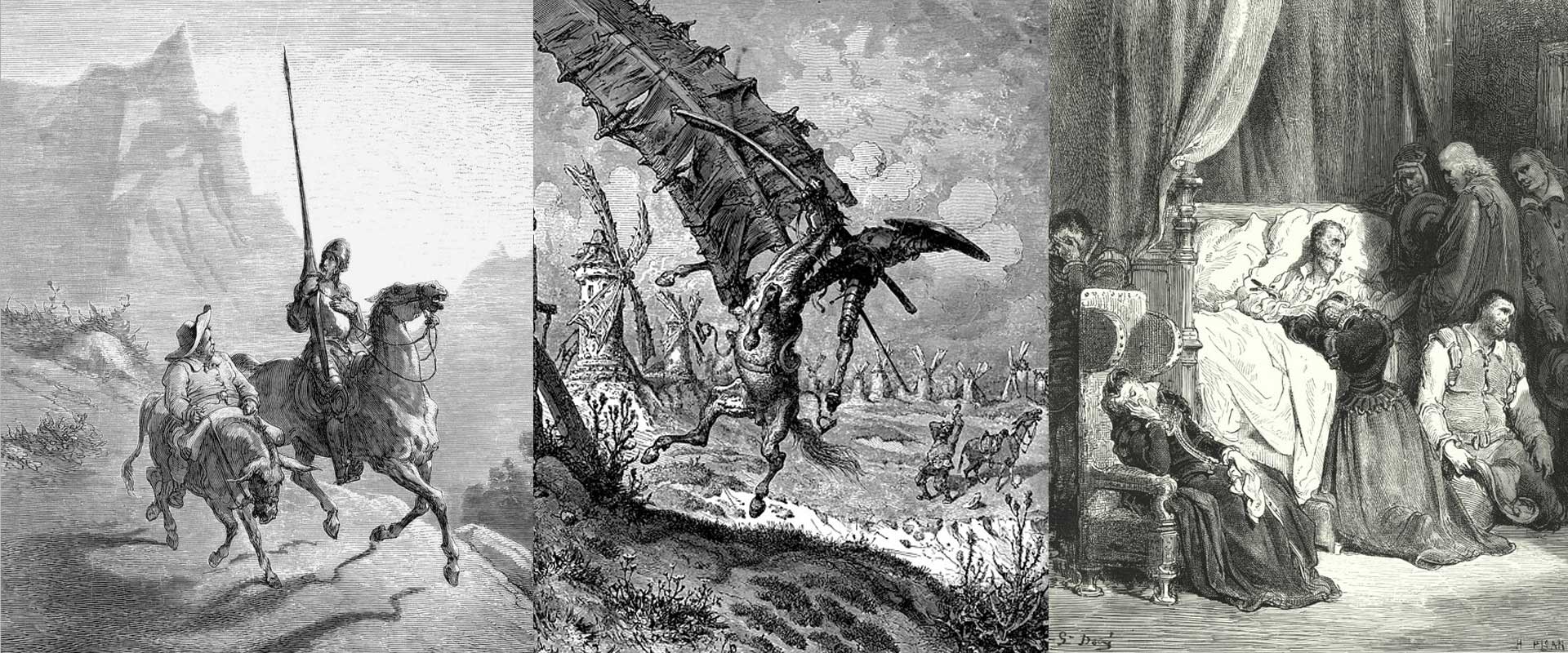When Paul Gustave Doré turned his attention to Cervantes’ Don Quixote de la Mancha in the mid-19th century, he produced more than just illustrations—he created the definitive visual language of one of the world’s greatest novels. First published in 1605 and 1615, Cervantes’ story of the deluded knight and his loyal squire Sancho Panza is often called the first modern novel. Doré’s engravings, with their sweeping landscapes, dynamic movement, and emotional depth, transformed the way readers imagined Don Quixote.
For many, Doré’s illustrations are inseparable from Cervantes’ text. His art made the satire, tragedy, and humanity of Don Quixote accessible to generations, shaping the novel’s reception far beyond Spain. This article explores Don Quixote through Paul Gustave Doré’s art, showing how his engravings deepened the novel’s meaning and continue to inspire readers and artists alike.
Doré Meets Cervantes: A Perfect Match
Doré had already achieved fame with his illustrations for the Bible, Dante’s Divine Comedy, and Milton’s Paradise Lost. When he was commissioned to illustrate Don Quixote in 1863, he approached Cervantes’ masterpiece with his signature dramatic intensity and emotional realism.
- The edition was published in Paris and quickly spread across Europe and America.
- Doré created over 370 engravings for Don Quixote, making it one of his most ambitious projects.
- His work became the definitive artistic interpretation of the knight and his adventures.
Much like his Bible illustrations, Doré used light, scale, and human expression to highlight both the grandeur and folly of Don Quixote’s journey.
Don Quixote in Doré’s Artistic Vision
The Noble Yet Foolish Knight
Doré portrays Don Quixote as both heroic and absurd. His tall, gaunt frame is often contrasted with the massive windmills he mistakes for giants, emphasizing both courage and delusion.
Sancho Panza: Earthly Balance
In contrast, Sancho is drawn with roundness and warmth, embodying practicality and humor. Doré’s ability to render this contrast visually reinforces the novel’s balance between idealism and reality.
The Landscapes of La Mancha
Doré’s sweeping Spanish landscapes, filled with dramatic skies and vast plains, situate Quixote’s adventures in an environment that feels both mythic and grounded.
Iconic Scenes Captured by Doré
The Windmill Encounter
Perhaps the most famous image, Doré captures Don Quixote charging a towering windmill. The engraving’s swirling motion dramatizes the futility of his quest, while also honoring his relentless bravery.
The Penitence in the Sierra Morena
Doré shows Quixote in wild penance, half-mad and consumed by his chivalric ideals. The shadows reflect the psychological depth of Cervantes’ satire.
The Return Home
In the novel’s closing, Doré depicts an aged, weary Quixote returning home. The engraving shifts in tone—less dramatic, more tender—signaling the novel’s bittersweet ending.
These scenes highlight why Doré was more than an illustrator—he was a storyteller with a chisel and ink, embedding emotion into every line.
Doré’s Artistic Style in Don Quixote
- Use of Scale: Doré often made Quixote appear small against massive landscapes, underscoring the futility of his quests.
- Light and Shadow: Beams of light in dark scenes echoed Quixote’s idealism amid delusion.
- Motion and Drama: Even still engravings felt alive, with horses rearing, cloaks billowing, and windmills spinning.
- Human Expression: From Sancho’s skepticism to Quixote’s feverish determination, Doré excelled at capturing personality.
This approach gave Don Quixote the same dramatic weight as Doré’s dramatic illustrations of the Bible, showing his mastery across sacred and literary texts.
The Enduring Legacy of Doré’s Don Quixote
Doré’s engravings became the visual archetype of Don Quixote. Later artists, from Picasso to Dali, engaged with the novel through Doré’s lens. Even film adaptations often echoed his imagery.
- His work influenced Romantic and modern art alike.
- Many readers first encountered Cervantes through Doré’s engravings, making his art integral to the novel’s global reach.
- Doré’s ability to blend satire with sympathy ensured Don Quixote was not only a figure of ridicule but also of admiration.
Today, Doré’s Quixote remains a cultural icon—standing for idealism, folly, and the eternal human struggle to reconcile dreams with reality.
Comparison of Doré’s Don Quixote Illustrations
| Scene | Theme | Doré’s Focus | Impact on Readers |
|---|---|---|---|
| Windmills | Delusion vs. bravery | Dramatic scale and motion | Defines Quixote’s iconic madness |
| Penitence in the Mountains | Idealism and obsession | Dark, shadowy composition | Reveals psychological intensity |
| Sancho’s Loyalty | Earthly wisdom | Warmth and humor in detail | Balances satire with humanity |
| Quixote’s Death | End of illusions | Tender portrayal of age | Leaves readers with sympathy and sorrow |
Conclusion
Paul Gustave Doré’s engravings for Don Quixote remain one of the most powerful artistic achievements of the 19th century, blending satire with sympathy and elevating Cervantes’ text to epic visual drama. His Don Quixote is at once heroic and foolish, tragic and inspiring—embodying the timeless human struggle between dreams and reality. These engravings not only defined how readers see Cervantes’ knight but also influenced generations of artists and storytellers. To explore more of Doré’s legacy and bring his vision into your home, you can discover his Bible art prints and spiritual collection, which showcase the same dramatic mastery applied to Scripture. Doré’s Don Quixote remains not just an illustration of a novel, but a window into the enduring human imagination.
FAQs on Exploring Don Quixote Through Paul Gustave Doré’s Art
Why is Doré’s Don Quixote so famous?
Because Doré captured both the satire and humanity of Cervantes’ novel, creating engravings that became iconic worldwide.
How many illustrations did Doré make for Don Quixote?
He created over 370 engravings, one of his most extensive illustration projects.
What makes Doré’s style unique in Don Quixote?
His use of scale, shadow, and expression elevated the humor and tragedy of the story simultaneously.
Did Doré’s Don Quixote influence other artists?
Yes, artists like Picasso and Dali engaged with Cervantes’ work after Doré defined its visual identity.
Where can I view Doré’s Don Quixote illustrations today?
They remain widely published and are also available as fine Paul Gustave Doré art prints.





